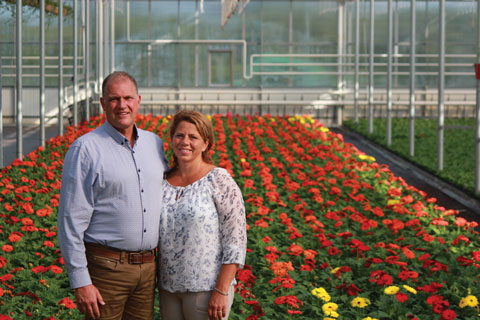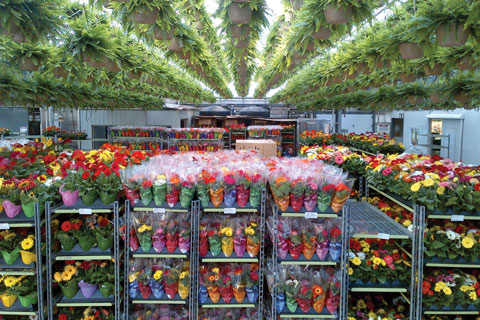5/1/2020
Tropicals & Foliage: Grow Your Own
Bill Calkins

For many years, growing indoor plants and tropicals has been the duty of large wholesale nurseries in Southern climates, like Florida. With established supply chains trucking hot-blooded varieties to garden centers of all sizes across the U.S., most got what they needed to satisfy shoppers. Perhaps the quality didn’t always meet the standards expected and bugs hitched a ride, but the gardening public seemed satisfied and sales remained steady.
Pictured: Orchard Park owners, Gerard and Jennifer Schouwenaar.
As trucking costs rose, and more and more retailers expressed a desire for niche products, smaller deliveries, and local or regional production, greenhouses began stepping in to supply indoor plants and tropicals. This wasn’t always easy, but as global partnerships began to form and producers climbed the learning curve improving production strategies and selection of the most appropriate varieties, some folks got a handle on what to grow and how best to supply.
At Orchard Park Growers in St. Catharines, Ontario, Canada, the team has been growing potted gerbera for more than 20 years and has more recently added Christmas cactus (zygocactus), lavender, mandevilla, bougainvillea and passion flower (passiflora) vines to the mix. Their staple crop is still weekly potted gerbera.
All the way over on the West Coast of the U.S., Sunlet Nursery in Fallbrook, California, has made a name for themselves growing a range of color crops, seasonal plants and tropical plants, with 40% of production in foliage. Mainstays like hypoestes and ferns join trendy favorites, including zebra plant (aphelandra) and pilea to serve a range of retail customers who have come to rely on Sunlet’s quality and attention to detail.
Both of these greenhouses serve local markets, as well as more distant regional customers, with top-notch and ever-evolving assortments. They’ve both seen growth in the past few years and cite the indoor plant boom with younger shoppers and homeowner’s desire for tropical blooms as market drivers, but both also rely on strong relationships with input suppliers and a nimble approach to shifts in popular plant trends.
Adding to the mix
Owner and business manager at Orchard Park Gerard Schouwenaar explained the decision to add Christmas cactus to their offering three years ago came as a result of other growers getting out of the crop, leaving a hole in the market that Orchard decided to try to fill.
“There were only a few other growers doing zygocactus in a big way,” he said. “We added 4- and 6-in. as a full-year crop to grow.”
In an effort to deliver a high-quality crop, they started adding an extra cutting per pot, using four instead of three, he added.
When expanding to include tropicals like mandevilla, passion flower and bougainvillea, Orchard identified gaps in the market, like they did with zygocactus, and developed programs that were easy for their customers to understand. They’ve actually been growing mandevilla and passion flower for about a decade, while bougainvillea is much more recent. What has helped them stand out from the crowd is a product range that includes 5-in. pots with a trellis, gallons, 2 gallons and 3 gallons.
“We offer these in the same sizes and at the same price points,” Gerard explained. “This makes it easy to understand.”
They also can offer customers mixed racks, which increases ordering flexibility and allows for shopper-friendly store displays.

Supply chains & relationships
In the past, growers frequently had challenges procuring disease-free and viable inputs for tropicals and foliage. Holding stock plants, especially in colder climates, was difficult and much of the young plant, and subsequently finished, production was left to nurseries in the South. But things have changed. Buying good, clean young plants has become much easier and both Orchard Park and Sunlet Nursery have developed strong relationships with breeders and suppliers making it much easier to start strong, healthy crops with minimal losses early on.
Janet Kister, Sunlet’s owner, said the company is able to get the high-quality inputs they need.
“No question, yes,” she said. “We receive excellent TC, seed, bulbs and cuttings.”
Pictured: Well-packaged assortments help retailers meet consumer demand for tropicals and foliage.
Sometimes they have to wait for more popular items, but they eventually arrive in time for production, she explained.
“For bougainvillea, we work with growers in the Netherlands to receive URCs shipped direct to the greenhouse,” Gerard said. “And we visit them every year.”
His team is just as engaged with their sources for other crops and specialists around the world who have the most knowledge. Like most things in our industry, success comes down to relationships.
Specialist considerations
Producing tropical plants and foliage definitely requires the right facilities and experienced professionals. Many of the crops are long in terms of time in the greenhouse, and the mindset is different than that of annual color growers. Both Sunlet and Orchard have years of experience with many of these species and a commitment to continuous education, as well as the appropriate facilities.
“You must have a heated greenhouse,” Janet said. “And labor is expensive and scarce, so efficient systems and material handling processes are important.” Foliage can be easier to grow than flowering plants, but it has idiosyncrasies, she added.
Gerard explained the facilities needed for the range of items produced by Orchard is as diverse as the crops themselves.
“Our lavender is grown in freestanding, cool houses, while the bougainvillea and tropical crops grown through the winter are in facilities with lighting and floor heat,” he said. “The heated floors are key and we’ve been investing in facilities over the years.”
In terms of grower education, Gerard said his team works hand in hand with the breeding companies that supply their genetics.
“Our head grower is Dutch and meets regularly with other Dutch growers producing the same crops,” he said. “We also conduct week-by-week walkthroughs with breeders.”
He goes on to admit that the first year with a new crop is always challenging, but year two is better. It’s a curve, but again, relationships are key.
Present & future
At this time, there are many factors making it possible for growers like Sunlet and Orchard to be able to compete effectively in a market that’s historically been dominated by Southern growers. While they don’t have the benefit of a perfect climate for tropicals and foliage, they capitalize on other strengths and differentiators.
“There’s a big market for customers who can’t take a full truck,” Janet explained. “Sunlet can supply flowering potted plants, adding on foliage items.”
It’s this kind of one-stop-shop mentality, coupled with an unwavering attention to quality, that keep retailers coming back for more. And relationships built on mutual respect and a deep understanding of the needs of each store benefit both parties.
Based in Ontario and working with a strong group of local growers allows Orchard to not only fit into a supply chain covering a wide range of specialty crops, but also allows for good geographic coverage and competitive shipping rates.
“We are as close, or closer, to the East Coast of the U.S. as Florida growers,” he said. “We’re eight hours from New York City and can supply half of the U.S. population in 24 hours.”
Another differentiator Gerard cites is the company’s move to a 100% biological strategy that’s resulted in significantly lower pest issues. He’s proud of their indoor-grown, very clean product and says that while in the past they were too expensive to compete on a large scale, they’re now very competitive.
Both Janet and Gerard are optimistic about the future of indoor plants and tropicals. They’re both also quite cognizant that market trends are always shifting.
“The indoor market has been positive lately,” Gerard said. “There’s a desire and interest in these plants.” It’s also challenging because a good percentage is holiday based, he said. “We have to continue to be innovative and not stand still.”
Janet says one of the recent game-changers driving increased consumer demand is social media.
“Instagram and Pinterest hit so many young people,” she said. “These drive trends. In the past, there was no widespread forum, but that’s changed.”
Historically, only true gardeners followed the latest plants via magazines and the market was small, she added.
Industry demand is up. Production strategies and new genetics are in place, allowing for excellent crop quality. Niche plants have visibility to new shoppers via social media. And retailers of all sizes are stepping up to implement seasonal programs and larger footprints for tropicals and foliage. Isn’t it great when everything falls into place? GT